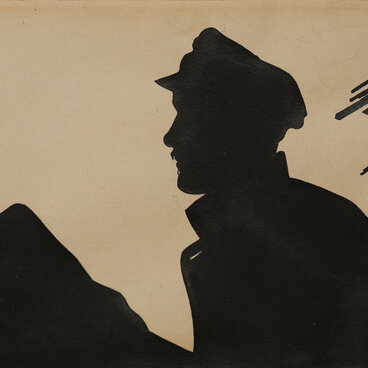Vladimir Donatovich Ovchininsky was the son of Mariya Berezovskaya, the great-grandniece of Mikhail Lermontov. He was born in Moscow in 1939. In 1957, he graduated from an art school. He studied in a class led by the teacher Ilya Tyomkin.
In 1958, Vladimir Donatovich had a change of heart and, instead of pursuing a career in art, he entered the Moscow Geological Prospecting Institute. He went on expeditions in the Far East — in the Amur region, along the coast of the Strait of Tartary and the Sea of Okhotsk. There he took up painting again.
The genres and content of Vladimir Ovchininsky’s paintings are diverse, with the prevalence of the landscape, including the urban one. He painted views of Tbilisi, Moscow, Lviv, and Kargopol. There is a number of his genre paintings. The artist also created an outstanding small literary series dedicated to the creative path and background of writers.
The canvas on display shows Mikhail Lermontov with friends before his last trip to the Caucasus. The painting renders the anguish of parting, the poetry of the irretrievable past, and the foreboding of a tragedy.
To fulfill his vision, Vladimir Ovchininsky chose the impasto technique. The narrative is expressed through the image of a table stretching diagonally from the bottom left corner to the upper right. At the table is a group of officers sitting in a relaxed way. The artist places Mikhail Lermontov in the lower-left corner. The poet is wearing the officer’s uniform of the Tengin Infantry Regiment and holding a guitar in his hands.
The attention of the viewers is captured by the figures of the poet and his inner circle. The table with drinks occupies a central position. The tilted angle of the painting emphasizes Lermontov’s anxiety and sadness. The artist uses this composition to express the main idea of the work, and that is Mikhail Lermontov parting with his friends.
The monogram of Vladimir Ovchininsky, as well as the date of creation of the painting, are indicated in the bottom left corner. The painting was shown at the exhibition titled “Carrying on the Tradition” which was organized by the Lermontov Heritage Association in Pyatigorsk in 1993.
In 1958, Vladimir Donatovich had a change of heart and, instead of pursuing a career in art, he entered the Moscow Geological Prospecting Institute. He went on expeditions in the Far East — in the Amur region, along the coast of the Strait of Tartary and the Sea of Okhotsk. There he took up painting again.
The genres and content of Vladimir Ovchininsky’s paintings are diverse, with the prevalence of the landscape, including the urban one. He painted views of Tbilisi, Moscow, Lviv, and Kargopol. There is a number of his genre paintings. The artist also created an outstanding small literary series dedicated to the creative path and background of writers.
The canvas on display shows Mikhail Lermontov with friends before his last trip to the Caucasus. The painting renders the anguish of parting, the poetry of the irretrievable past, and the foreboding of a tragedy.
To fulfill his vision, Vladimir Ovchininsky chose the impasto technique. The narrative is expressed through the image of a table stretching diagonally from the bottom left corner to the upper right. At the table is a group of officers sitting in a relaxed way. The artist places Mikhail Lermontov in the lower-left corner. The poet is wearing the officer’s uniform of the Tengin Infantry Regiment and holding a guitar in his hands.
The attention of the viewers is captured by the figures of the poet and his inner circle. The table with drinks occupies a central position. The tilted angle of the painting emphasizes Lermontov’s anxiety and sadness. The artist uses this composition to express the main idea of the work, and that is Mikhail Lermontov parting with his friends.
The monogram of Vladimir Ovchininsky, as well as the date of creation of the painting, are indicated in the bottom left corner. The painting was shown at the exhibition titled “Carrying on the Tradition” which was organized by the Lermontov Heritage Association in Pyatigorsk in 1993.



